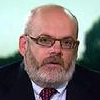St. Louis Federal Reserve President James Bullard on Friday said he wanted to cut interest rates this week to guard against an outlook of slowing growth and weak inflation.
In a brief statement posted on his bank’s website, Bullard said that lowering interest rates this week “would provide insurance against further declines in expected inflation and a slowing economy subject to elevated downside risks.”
The Fed voted 9-to-1 to hold its benchmark short-term rate steady on Wednesday with Bullard as the sole dissenter. It was the first dissent under Fed Chairman Jerome Powell’s tenure.
See: Fed holds steady, removes ‘patient’ language
Powell acknowledged at his press conference that the case for policy easing had strengthened but said many Federal Open Market Committee members wanted more evidence about the economy before easing policy. Most Wall Street economists think the central bank will cut interest rates this year, with many seeing a move at the next FOMC meeting in late July.
Read: What would it take to stop a July rate cut? A lot.
Bullard said a quarter-point rate cut this week would have been the most appropriate course of action.
He said that core and headline inflation, as measured by the Fed’s preferred personal consumption expenditure index, have declined substantially since the end of last year and are now running some 40 to 50 basis points below the Fed’s 2% inflation target.
Market-based measures of inflation expectations have also weakened, he said.
“The forces that are keeping inflation below target seem unlikely to be solely transitory,” Bullard said.
At the same time, Bullard said economic growth is expected to slow for the rest of the year and uncertainties about the outlook have “recently increased.”
“Even if a sharper-than-expected slowdown does not materialize, a rate cut would help promote a more rapid return of inflation and inflation expectations to target,” he said.
In an interview on Bloomberg Television shortly after Bullard’s statement was released, Fed Vice Chairman Richard Clarida stressed that he thought the economy would continue to grow but tied rising worries to global trade tension.
“I think our outlook is for a sustained economic expansion. We could see some moderation in growth this year, but the economy’s baseline outlook is good: sustained growth, a strong labor market and inflation near our objective,” he said.
With this bright backdrop, Clarida said the talk about rate cuts was due to rising uncertainty about the outlook over the last six to eight weeks.
“There has been a marking down of global growth prospects, there is uncertainty about international trade.There is some evidence that is weighing on sentiment a bit , so we’re monitoring that closely and we will act as appropriate to sustain [the] expansion,” Clarida said.
Still, Clarida said the case for “accommodation” has increased since the spring.
“We have the tools necessary to sustain expansion, a strong labor market and stable prices and as appropriate we will deploy those tools to achieve those goals,” he said.
“I don’t think we’re stuck at all,” he said.
U.S. stock futures were pointing to a weaker start for the Dow Jones Industrial Average DJIA, +0.94% on Friday. The yield on the 10-year Treasury TMUBMUSD10Y, +0.24% was 2.06%, down from around 3.2% in November. The yield on the 2-year Treasury TMUBMUSD02Y, -0.54% fell 3 basis points to 1.76%.


